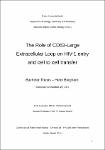The Role of CD63-Large Extracellular Loop on HIV-1 entry and cell to cell transfer
Burghard, Heidi
Regarding to the World Health Organization’s 2011 published list of the top ten causes of death worldwide, HIV/ AIDS is still listed as the 6th most frequent reason for fatality. Previous analyses with a Yeast two-hybrid (Y2H) screen identified the tetraspanin CD63 as an interaction partner of the HIV-1 protein gp41 and unveiled some highly conserved cysteines in its Large Extracellular Loop as involved interaction sites between those two proteins. The aim of this study was to investigate the role of the CD63's Large extracellular loop on HIV-1 entry and cell-to-cell transfer. For this purpose several expression plasmids encoding for recombinant variants of the Large Extracellular Loop were generated. One did express the CD63 without the whole loop and four contained in each case a different mutation of one or two of the six cysteines. Studies of the recombinant protein's expression with the confocal laser scanning microscope showed that only one cystein mutant was completely expressed like the wild type CD63. Two cysteine mutants were not expressed consistently throughout the HEK293T cells and one appeared to be not expressed on the surface of the plasma membrane. Surprisingly, recombinant protein without the Large Extracellular Loop was expressed predominantly on the surface of the plasma membrane. Subsequently some foreign protein sequences were introduced instead of this loop. It could be confirmed that these foreign proteins can be added without affecting the overall efficiency of the proteins integration into the cell membrane. Furthermore, introducing certain foreign proteins does neither affect the protein folding nor the protein orientation. Once this membrane transport system is established, it could be used in the field of immunisation studies, antibody production or other immunological experiments, where the exposure of certain proteins on the cell surface of mammalian cells is of interest. Unfortunately, due to strict time constraints experiments investigating the recombinant protein's influence on HIV-1 entry and cell-to-cell transfer could not be performed. The results gathered during the course of this research revealed some promise of usefulness. However, in regards to the CD63's overall influence on cell free virus infectivity and cell-to-cell transfer in T lymphocytes, it would appear the current understanding is that no significant influence can be shown. This would suggest that, here too, no significant results are to be expected.
Dateien zu dieser Publikation
Keine Lizenzangabe

